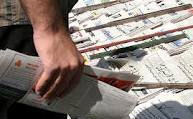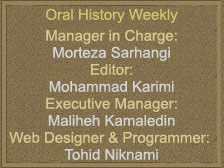| No. 212 | 26 July 2015 |
“In the Alleys and Streets” with Dr. Abbas Manzar PourLast year, we found the opportunity to talk intimately to Dr. Abbas Manzar Pour the writer of “In the Alleys and Streets” in the house of his respected son. Although the talk took more than three hours, it was so intimate and sweet that we did not feel the passage of time. “In the Alleys and Streets” has so far been republished for several times (five times) and warmly welcomed by the readers. It is among the useful works in the area of anthropology and social history of the city of Tehran. In the following interview, we asked and heard about his book and other historical issues in the past century. Here is the excerpt of the interview with Dr. Manzar Pour:Face to face with Ibrahim GolestanWriting with CameraWriting with Camera is the title of a controversial book by Parviz Jahed in a long dialogue with filmmaker and author of the style in the period from June 2002 to December 2003 with Ibrahim Golestan. In his PHD dissertation, Parviz Jahed, in his book is trying to analyze the origins of “New Wave” in Iran’s cinema in the period of 1959 to 1969 and focuses on three prominent and pioneer directors in elite and unconventional cinema of Iran who are Ibrahim Golestan, Farokh Ghaffari and Fereydoun Rahnama.Best Interview Techniques Published in “Professional Chat”The audience in “Professional Chat” book is not an oral historian but is the Interviewer of Oral Memories. Instead of looking into documents and evidence we located people who had created events or witnessed incidents directly. Applicable key points were published by Reza Mostafavi in Professional Chat regarding interviews for oral memories. The book consists of eighty sections with different topics such as “setting the point of view right”, “people and their memories are two groups”, “focus on mutual emotions”,...Looking at the student movement in Mashhad (1)Naqi Lotfi’s narration of student activities in Mashhad before RevolutionAfter the coup of August 19, 1953(28 Mordad), Iran's student movement emerged vividly and through protests and demonstrations of Tehran University students, it was actually entered to the fight scene. The day after the coup of 28 Mordad a demonstration occurred at Tehran University in support of Dr. Mossadegh (1), and subsequently student’s protests was widespread. Following students’ protests to the imprisonment and trial of Dr. Mossadegh and Dr. Shayan and engineer Razavi, The first widespread protests lead to the National Resistance Movement (2) initiative On October 8th 1953 (16 Mehr 1332), and ... Oral History Weekly Magazine Aims and Regulations
Oral History Weekly Magazine wishes to create a suitable place for thoughts and idea development; Its main field would be “Oral History” and subjects as telling & writing memoirs, writing diaries, travelogues, chronologies, and all other subfields of history which are presented in the form of news, articles, reports, notes, interviews and memoirs can be included. There is no limitation on the length of would-be-sent materials. Mentioning the name, academic background and email is necessary. Articles with complete references and bibliography are more credited and an abstract would quite helpful. Weekly is not about to publish any material consisting insults and libels about other people or anything that brings anxiety to public opinion. Weekly can edit and translate the received materials. The published articles and materials are only the writer’s ideas and Oral History Weekly Magazine has no responsibility about their content. |
   Daughter of Sheena-41 This time he was punctual and came back home about twenty days later. He showed more affection than before. He took Mahdi wherever he went. “I know Mahdi is a naughty boy and bothers you.” He said.   |

